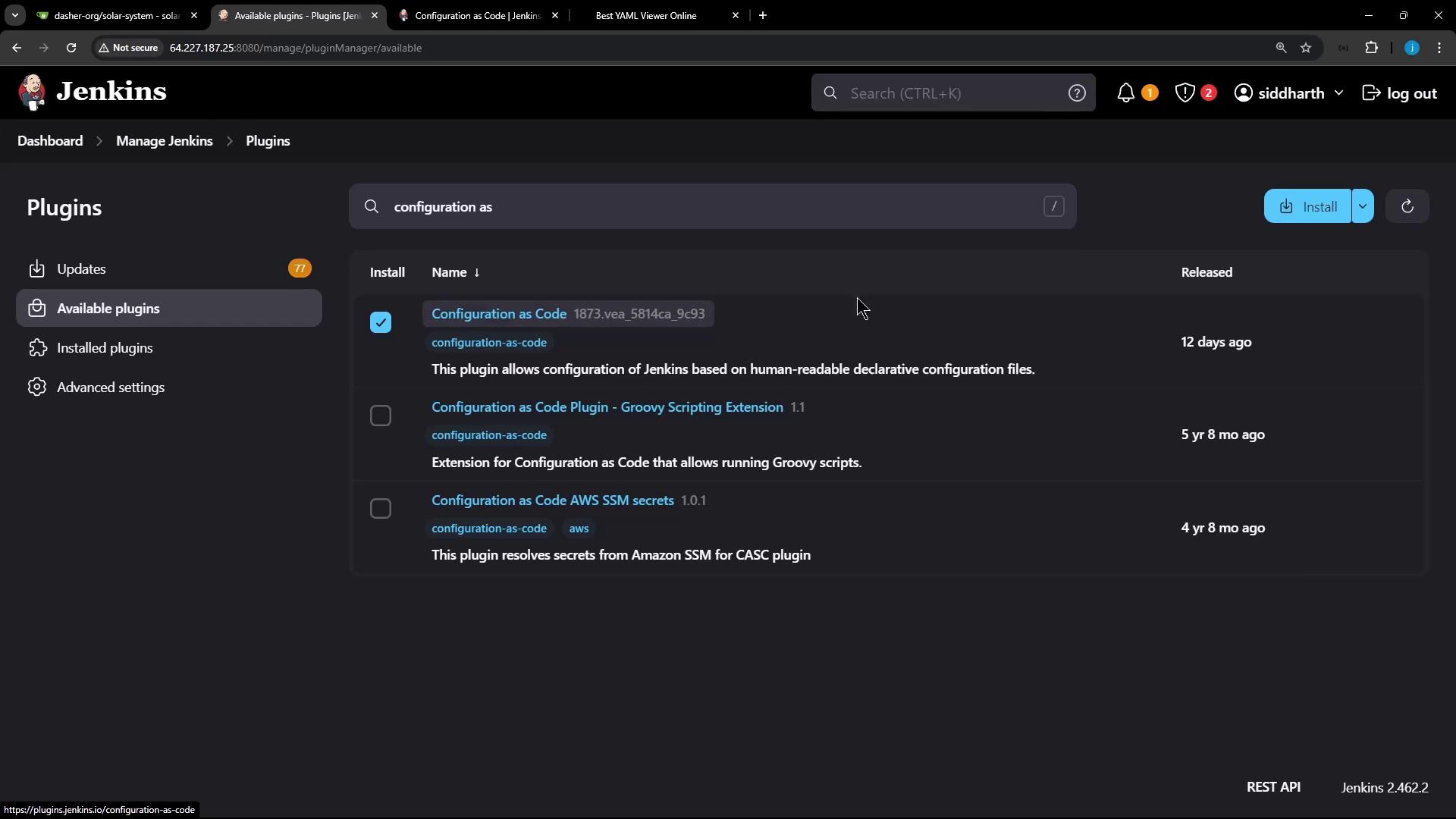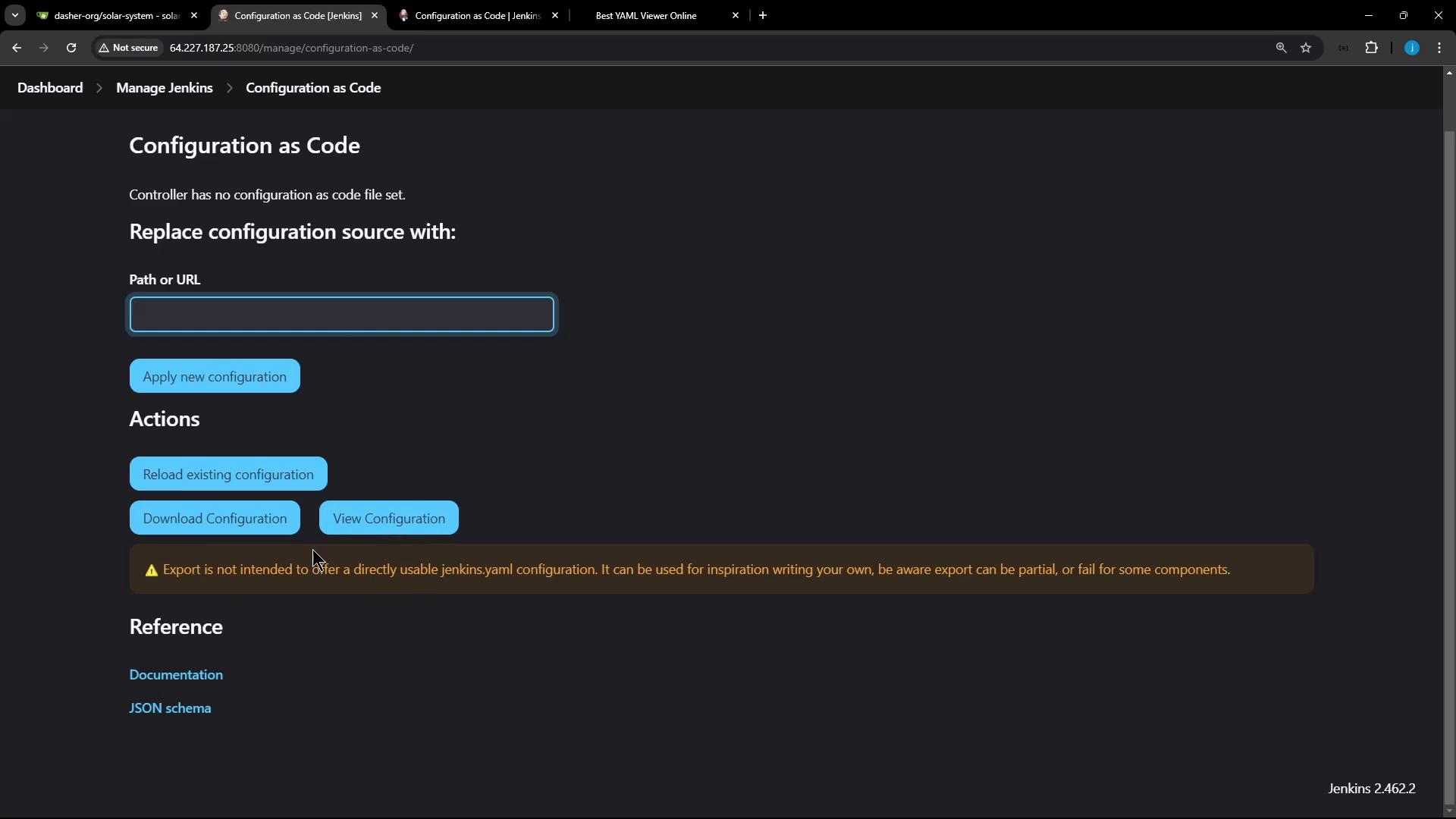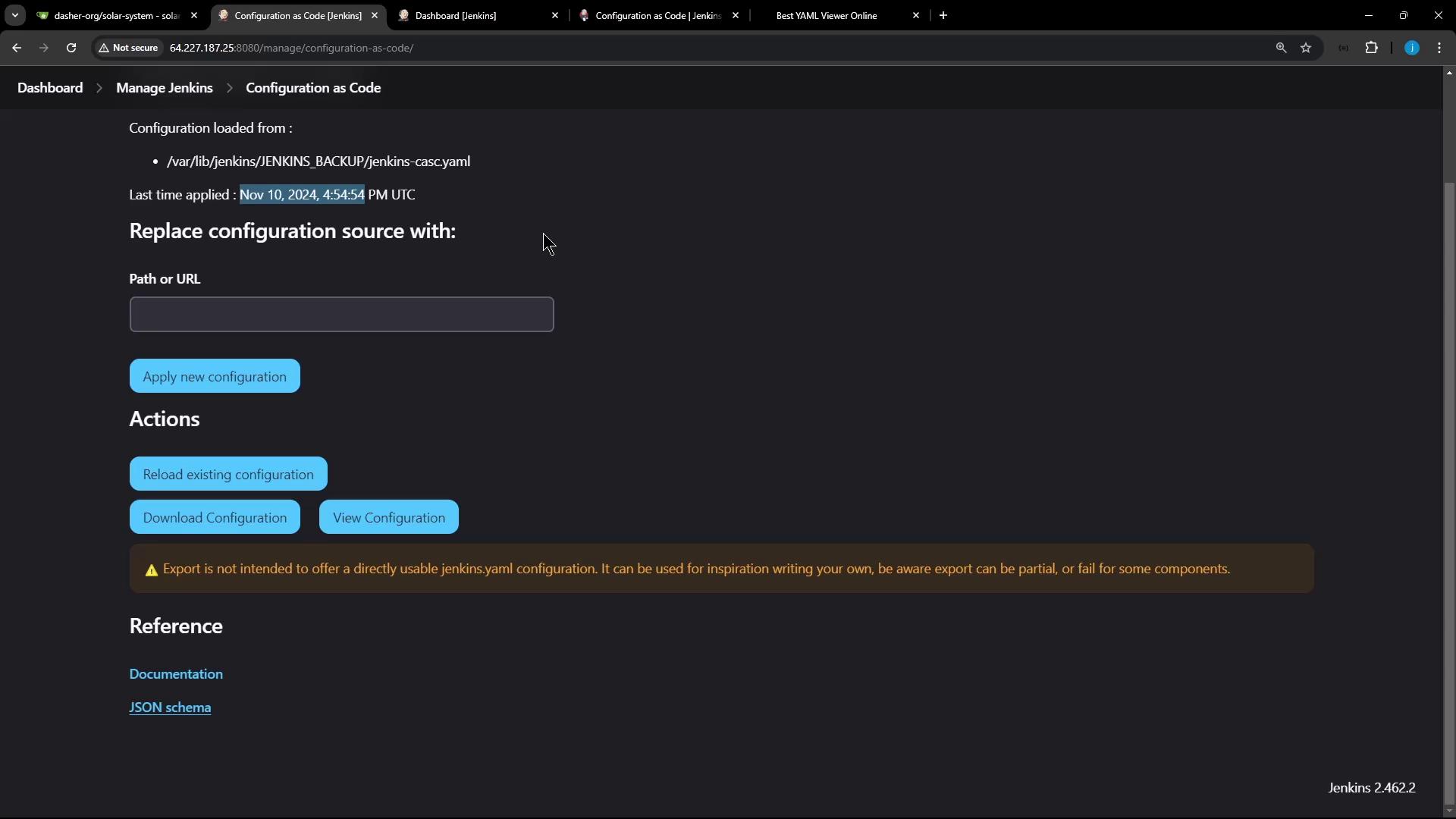Certified Jenkins Engineer
Backup and Configuration Management
Demo Configure and Explore JCasC
Managing Jenkins through dozens of UI screens can be tedious. With the Configuration as Code (CasC) plugin, you define your entire Jenkins setup—including core settings, security, plugins, tools, and credentials—as YAML. In this guide, you’ll learn how to:
- Install and enable the CasC plugin
- Inspect your live Jenkins configuration
- Modify a setting declaratively and apply it
- Validate and reload configurations
1. Installing the Configuration as Code Plugin
- In Jenkins, go to Manage Jenkins → Manage Plugins → Available.
- Search for Configuration as Code, select it, and click Install (restart if prompted).

After restart, you’ll see Configuration as Code under Manage Jenkins → System Configuration.
2. Exploring the Current Configuration
Navigate to Manage Jenkins → Configuration as Code. Here you can:
- View Configuration: Download the live settings as YAML or JSON
- Replace Configuration: Point to a file on disk or a Git repo
- Reload: Reapply the last loaded settings

2.1 Downloaded Configuration Example
When you download your live settings, Jenkins outputs JSON or YAML. Below is a shortened JSON excerpt:
{
"jenkins": {
"systemMessage": "Jenkins is ready to use.",
"numExecutors": 5,
"mode": "EXCLUSIVE",
"scm": { "gitHub": "global-git-hub" },
"credentials": [
{
"scope": "GLOBAL",
"id": "gh_repo_secret_token",
"username": "GitHub Username",
"password": "GitHub Token"
}
]
}
}
CasC automatically converts JSON into YAML. A typical YAML will include sections like:
jenkins:
systemMessage: "Jenkins is ready to use."
numExecutors: 5
mode: "EXCLUSIVE"
security:
apiToken:
tokenGenerationOnCreationEnabled: false
unclassified:
auditTrail:
displayName: true
tools:
maven:
installations:
- name: "M308"
properties:
- installSource:
installers:
- maven:
id: "3.9.8"
nodejs:
installations:
- name: "nodejs-22-6-0"
properties:
- installSource:
installers:
- nodeJSInstaller:
id: "22.6.0"
2.2 YAML Section Reference
| Section | Description | Example Fields |
|---|---|---|
| jenkins | Core Jenkins settings | systemMessage, numExecutors, mode |
| security | Security and API token management | apiToken.tokenGenerationOnCreationEnabled |
| unclassified | Plugin-specific configurations | auditTrail, slackNotifier |
| tools | Tool installers (Git, Maven, Node.js) | maven.installations, nodejs.installations |
| credentials | Credentials domains and secrets | usernamePassword, string |
2.3 Credentials Example
credentials:
system:
domainCredentials:
- credentials:
- usernamePassword:
id: "gitea-server-creds"
description: "Gitea Server Credentials"
username: "gitea-admin"
password: "{AAABAAAAQ4e7IwFYLRu0yZlNsLqahKkpJFtDGTyKUsxQCU=}"
scope: GLOBAL
- string:
id: "sonar-qube-token"
description: "SonarQube Server Token"
secret: "{AAABAAAAQpXMpOkYc2h9v0KshvCkdK8c9207YLPcYZ3ot64=}"
scope: GLOBAL
Note
You can explore more sections like global security, authorization strategies, and plugin settings by scrolling through the full YAML.
3. Modifying Configuration via CasC
Let’s update the Jenkins system message. First, back up and edit your YAML on the controller:
cd /var/lib/jenkins/JENKINS_BACKUP
cp /var/lib/jenkins/casc.yaml jenkins-casc.yaml.bak
vi jenkins-casc.yaml
Add or update the remotingSecurity block:
remotingSecurity:
enabled: true
slaveAgentPort: 0
systemMessage: "Loading data from Jenkins Configuration as Code"
Then, on Manage Jenkins → Configuration as Code, use Replace Configuration to point to:
/var/lib/jenkins/JENKINS_BACKUP/jenkins-casc.yaml
Click Apply New Configuration. Jenkins will validate and apply the YAML, displaying a load timestamp.
Warning
Always back up your YAML and test in a non-production instance before applying major changes.
4. Applying and Reloading Configuration
On the CasC page you can also:
- Reload Existing Configuration: Reapply last known-good settings
- Download Current Configuration: Fetch live YAML/JSON
- View Documentation: Open [JCasC docs][casc-doc]
- View JSON Schema: Inspect the schema for valid YAML
Here’s a snippet of the JCasC JSON schema:
{
"$schema": "http://json-schema.org/draft-07/schema#",
"description": "Jenkins Configuration as Code",
"type": "object",
"properties": {
"security": {
"type": "object",
"properties": {
"apiToken": { "type": "object" }
}
},
"cps": {
"type": "object",
"properties": {
"hideSandbox": { "type": "boolean" }
}
}
}
}

For more details, see the [official CasC documentation][casc-doc] and explore the [Jenkins schema reference][casc-schema].
Links and References
- Jenkins Configuration as Code (CasC) [casc-doc]
- Jenkins JSON Schema Reference [casc-schema]
- Jenkins Official Documentation
Watch Video
Watch video content